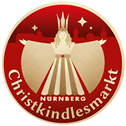A Symbol for Nuremberg: The Origin of the Christkind
He told his children that "Holy Christ" had brought their presents. This tradition quickly took hold in Lutheran families. In Nuremberg, it was already common by the end of the 16th century.
Through the years, this fictional gift-giver took on form. It was most likely the medieval German tradition of Christmas plays, with an Angel of the Annunciation as the main character, which gave the Christmas Angel its earthly appearance. As angels of all sorts began to be depicted as female and not only male, the Christkind also took on a feminine appearance. That is why today a young woman is chosen to play the part of the Nuremberg Christkind.
In 1948, the first Christkindlesmarkt after World War II took place in the destroyes Old Town. The young Nuremberg actress Sophie Keeser was chosen to open the markt. She occupied this role for 13 years, until 1961. The next Christkind, Irene Brunner, was also an actress in Nuremberg and worked until 1969. For more than 20 years, actresses played the Nuremberg Christkind, which in that time had only two tasks: To open the markt and give gifts to needy children. For 1969, everything would change.






